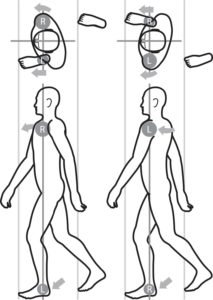
How to Walk the Perfect Posture Way
The Perfect Posture way of walking is the way of nature. It’s the way nature built your body to move while walking. It’s the balanced way of walking. When using the Perfect Posture way of walking your body swirls around your central axis or core, keeping you balanced while you move.
See the dissecting line in the illustration below right for some insight into what and where an axis or core is.
It’s a good time to become familiar with some terms used in the spring industry that apply equally to the human body, or any upright structure in nature. I use these terms often. The first term is “buckle”. This is the immediate effect an unbalanced load has on a spring. It’s easily seen, as shown in the illustration of the unbalanced spring and vertebrae on the right.
Another term I borrowed from the spring industry to describe the long term effects of an unbalanced load on the body is “creep”. It’s not so easily noted. This is the long term effects of an unbalanced load on a spring. It’s not an immediate effect. “Creep” also applies equally to the human body or any upright structure in nature that has a prolonged unbalanced load applied to it.
If a spring is positioned too long with an unbalanced load you get “creep”. This defines the slower, more permanent deformity that results from prolonged unbalanced positioning. A spring will not return to its symmetrical shape if its load has been unbalanced for prolonged periods. It’s the same with the body or any upright structure in nature. It’s happening to you right now if you’re standing, sitting or walking in a Type 1 manner.

The principles are directly comparable.
When your body stays balanced around your axis you stay toned front to back, side to side and top to bottom. It’s very sensible. It’s the same way a spring stays toned front to back, side to side, and top to bottom when it’s axis is kept centered.
Instructions for Walking
It’s not going to do you a lot of good to know how to stand without hurting your body, if you don’t know how to walk without hurting your body.
Therefore, I present instructions for a walking Perfect Posture. Below you see the instructions for walking body mechanics as laid down by Mother Nature.
Instructions For Balanced Walking Body Mechanics
- Do not snap the knee to the locked position with the forward stride.
- Shoulders relaxed, moving and symmetrical at all times.
- Don’t drop, plop, or thud from leg to leg on upon weight transfer.
- Opposite shoulder vertical to anklebone or ball of foot upon weight transfer.
Don’t Snap the Knee to a Locked Position In Forward Stride
It’s important to describe these points in more detail.
You shouldn’t lock the knee back when standing so don’t snap the knee to the locked position with the forward stride. It buckles the spine and compresses it even more with each snap of weight transfer.

Note the position of the shoulders and the unlocked knees.
Shoulders Relaxed, Moving, Symmetrical At All Times.
If your shoulders are not relaxed and moving symmetrically in a fashion that keeps you balanced around your axis, you again have the weight being transferred to a spine that is not centered around your core. This will further promote buckle, creep or physical deformity as you age. It takes a lot of exercise to beat gravity. A lot.
Don’t drop, plop or thud from leg to leg on weight transfer
If the weight transfer is not smooth, and symmetrical you are buckling your back at the completion of your forward stride. You are dropping all of your weight onto the weight-bearing heel, hipbone, back and surrounding structure. It’s coming down from the distance you lifted it in the apex of your stride. That’s the distance, or height, from the ball of your foot to your heel at weight transfer. It’s bad, bad and bad for the body.
Not only is your hip joint and surrounding structure carrying all the weight of your upper body, you have the added trauma of the body falling upon them. The weight transfer should be smooth with no bouncing or jarring. When your heel comes down on the floor in your forward stride, it should not make a lot of noise or rattle the house.
Opposite shoulder parallel to anklebone at weight transfer
You need to maintain your shoulders evenly parallel to the opposite anklebone or ball of foot while you move as you walk. This means, when your left foot is in the forward position of your stride, your right shoulder should be even or parallel with it in the side view…or close. Don’t overthink. Don’t try to be too perfect.
And the opposite applies. To keep your axis central and not throw your axial load out of balance as you walk, your left shoulder should be even with your right anklebone in the forward step and vice versa. It should be a fluid non-bouncing, non-jarring stride. This takes practice. Expect perfect form and feeling comfortable only after significant practice.
If you take short a step, move your opposite shoulder the same short distance backwards. If you take a long stride move your opposite shoulder backward a long distance. Balance the movement. Relax and let your shoulders flow with your stride. Don’t overthink or try too hard. Exaggerate the movement for a time to get the feel of it, then relax and let your natural inclinations and sense of balance take over.

The illustration demonstrates the principle of keeping the shoulders and feet symmetrical.
I started this Perfect Posture method when I was 28. I recall it took me 2 to 3 years to become comfortable with a balanced lifestyle and I’m still working on it.
You can notice immediate effects on many body parts when standing in the Perfect Posture way but it takes time and habituation to make the changes permanent and comfortable. It’s different with walking. It’s a movement so it’s difficult to see immediate effects while moving.
After all, you were never taught to stand, walk and sit in a biological or balanced manner. If you grew up in the west you have probably never stood, walked or sat in a natural or balanced position. It will take time to get comfortable.
Many web sites incorporate some points of correct walking but I could not find a single complete and balanced overview other than the Perfect Posture method. It serves as evidence as to how pervasive western civilization’s obsession with Type 1 or “proper” posture and walking is. It’s deeply imprinted on most in the west as children so it’s difficult to think outside this model.
I’ve searched the web for correct, proper, balanced, right, true, and even perfect way of walking. I could not find a single web site that included all points of movement referenced like the Perfect Posture way of walking.
So my suggestion is to look at the Feldenkrais Method, the Alexander Technique, or any Perfect Posture friendly, movement oriented discipline such as Pilates, Tia Chi, Yoga etc. They will help you become more flexible and comfortable in your new way of moving with your new body.
Stay tuned for a comprehensive review of various mainstream walking instructions. My blog “How to Walk the Mainstream Posture Way” will be out soon. It will have links and detailed critiques of various mainstream site instructions. Compare the instructions. Use your sensibilities. Save your body a lot of trouble as you age.
As always, remember these are guidelines. Don’t try to be too precise. It’s not possible to be perfect always. It’s all about movement. Above all…relax. Breath. Keep moving.

